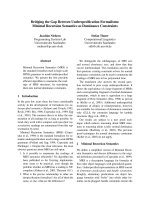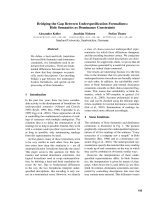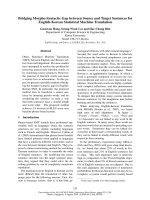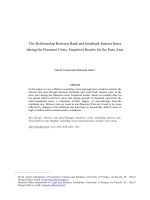BRIDGING THE GAP BETWEEN 2D AND CG pptx
Bạn đang xem bản rút gọn của tài liệu. Xem và tải ngay bản đầy đủ của tài liệu tại đây (15.67 MB, 368 trang )
TEAM LinG
©2007 Angie Jones and Jamie Oliff. All rights reserved. No part of
this book may be reproduced or transmitted in any form or by any
means, electronic or mechanical, including photocopying, recording,
or by any information storage or retrieval system without written
permission from Thomson Course Technology PTR, except for the
inclusion of brief quotations in a review.
The Thomson Course Technology PTR logo and related trade dress are
trademarks of Thomson Course Technology, a division of Thomson
Learning Inc., and may not be used without written permission.
“OSCAR®,” “OSCARS®,” “ACADEMY AWARD®,” “ACADEMY AWARDS®,”
“OSCAR NIGHT®,” “A.M.P.A.S.®” and the “Oscar” design mark are trade-
marks and service marks of the Academy of Motion Picture Arts and
Sciences. All other trademarks are the property of their respective owners.
Important: Thomson Course Technology PTR cannot provide software
support. Please contact the appropriate software manufacturer’s
technical support line or Web site for assistance.
Thomson Course Technology PTR and the authors have attempted
throughout this book to distinguish proprietary trademarks from
descriptive terms by following the capitalization style used by the
manufacturer.
Information contained in this book has been obtained by Thomson
Course Technology PTR from sources believed to be reliable.
However, because of the possibility of human or mechanical error by
our sources, Thomson Course Technology PTR, or others, the
Publisher does not guarantee the accuracy, adequacy, or completeness
of any information and is not responsible for any errors or omissions
or the results obtained from use of such information. Readers should
be particularly aware of the fact that the Internet is an ever-changing
entity. Some facts may have changed since this book went to press.
Educational facilities, companies, and organizations interested in
multiple copies or licensing of this book should contact the Publisher
for quantity discount information. Training manuals, CD-ROMs, and
portions of this book are also available individually or can be tailored
for specific needs.
ISBN-10: 1-59863-260-4
ISBN-13: 978-1-59863-260-6
Library of Congress Catalog Card Number: 2006923482
Printed in the United States of America
07 08 09 10 11 BU 10 9 8 7 6 5 4 3 2 1
Publisher and General Manager,
Thomson Course Technology PTR:
Stacy L. Hiquet
Associate Director of Marketing:
Sarah O’Donnell
Manager of Editorial Services:
Heather Talbot
Marketing Manager:
Heather Hurley
Executive Editor:
Kevin Harreld
Marketing Coordinator:
Meg Dunkerly
Project Editor/Copy Editor:
Cathleen D. Snyder
Technical Reviewer:
Scott Holmes
PTR Editorial Services Coordinator:
Elizabeth Furbish
Interior Layout Tech:
Bill Hartman
Cover Designer:
Mike Tanamachi
Indexer:
Sherry Massey
Proofreader:
Carla Spoon
Thomson Course Technology PTR, a division of Thomson Learning Inc.
25 Thomson Place
■
Boston, MA 02210
■
TEAM LinG
We would like to dedicate this book to
all the animation pioneers before us.
We are but fleas on the shoulders of giants.
TEAM LinG
Thinking Animation: Bridging the Gap Between 2D and CG
iv
The Magic of Animation
T
he theater was pitch-black as we made our way to our seats. I held
my mother’s hand because I couldn’t see a thing in front of me. Once
in our seats, I looked up at the towering screen and saw something
I’ll never forget. This was no ordinary movie, and the images on the screen
were clearly not real. Yet they were hyper-real in a unique kind of way. The
motion picture being screened that afternoon was Walt Disney’s Bambi, and
it was the first animated cartoon feature I had ever seen. Keep in mind, this
was the 1940s, and television had not yet invaded our lives. The only way
one saw an animated film was in a theater.
Though only a small child, I knew the images I was watching were colored
drawings. Yet these amazing drawings moved with life, had personality, and
spoke clever dialogue. What kind of magic was this, I wondered? Whatever
it was, this was something I wanted to do. This was something I had to do. That desire to bring life to
pencil drawings has never left me. From my first animated scribbles in junior high school to viewing my
early test footage at the Walt Disney studio, I continually remain in awe of moving drawings.
Over the years, I’ve been privileged to work with and learn from the best in the business. Masters whose
work I enjoyed as a child were generous enough to share their years of experience with me. Yet knowl-
edge can come from the most unlikely of places, so I’ve learned from kids as well as codgers. That’s
because we all shared the same passion, and continually searched for ways to improve our art.
This book continues that search, and you’ll find yourself a better animation artist because of it. That blank
sheet of pegged paper on your animation desk needn’t engender fear or trepidation, because it’s an
incredible challenge. It is the opportunity to create, for lack of a better word, magic.
—Floyd Norman (www.afrokids.com/floydsbio.html)
Floyd Norman,
Animator and Story Guy
TEAM LinG
Thinking Animation: Bridging the Gap Between 2D and CG
v
T
his book has been lovingly crafted by two tal-
ented animators who enjoy their work and
recognize the value of knowing the history, the
art, and the craft of animation.
Jamie and Angie have pooled the knowledge of
some truly talented professionals to help them con-
vey to the artist, animator, historian, or fan the com-
bination of technology, art, discipline, and heart that
it takes to succeed as a contemporary animator.
What a phenomenal time this is in the evolution of
animation and film. We are surrounded daily by the
most complex visual imagery that mankind has ever created; be it in print, movies, television, games, or
on the Internet, our lives are bombarded daily by images of seemingly limitless complexity. Today literally
any image that a filmmaker can imagine can be realized. True, some dreams cost more than others, but
the fact is the tools now exist that allow the artist, the animator, and the filmmaker to create photo-real
illusions, fantasy characters that entertain and amaze us in films such as Titanic, The Incredibles, Shrek,
Jurassic Park, King Kong, Lord of the Rings, Harry Potter, The Matrix, Alien, Terminator, Blade
Runner, Star Wars, and Tron. Films packed with astounding special effects pour out of the studios yearly
and on TV weekly. The technological tools to create this imagery are logarithmically improving as they
become faster, better, and cheaper annually.
Tron—interesting that I would mention that film. I was co-visual effects supervisor on the picture, which
was released in 1982. Tron was the film that introduced the world to computer imaging. So I’ve been
involved with computer animation since its first use in the film industry. I’ve watched as art and technol-
ogy fused to create the most powerful and limitless visual tool in the history of man. Computer-generated
imaging (CGI) is now the fundamental tool used in creating visual effects and animated features. If there’s
one thing I’ve learned over the years, it’s that computers and software don’t create these fantastic images.
A computer is analogous to a Steinway piano—it’s an instrument. It’s the artist who plays the instrument
who brings it to life.
So how does one become an animator who is adept at the latest technological advances, yet still creates
with the spirit and freedom of traditional hand-drawn animation? This book deals directly with that query
and should give you plenty of answers.
Richard Taylor, Director, Designer, and CG Pioneer
TEAM LinG
Thinking Animation: Bridging the Gap Between 2D and CG
vi
To begin with, production designers, directors, animators, and other artisans who are legendary in the
film industry have several things in common. They know how to draw, they study art and the history of
their craft, they hang out with their peers, they are objective, and they make an effort to learn something
new every day. But the most essential thing they have in common is self-discipline. Successful artists in
painting, photography, music, dance, or animation are joined in an endless dance with their art forms.
They put energy into the process daily, and in return it teaches them something new. The more you work
at an art process, the more it teaches you. This dance is the mother of happy mistakes and magical reve-
lations.
For those who love the art of animation and would like to make animation their life’s work, this book will
reveal some basic skills and understandings. Lean to draw 2D animation. The nature of hand-drawn ani-
mation allows the animator to exaggerate the elasticity, the personality of a character. Drawing by hand
creates a rhythm and flow that’s difficult to achieve in 3D work. It’s the human feeling, the personality, the
heart of the animator that can be realized through drawing. Dedicated animators observe the world
around them. They constantly watch the way things move; they analyze body language and know that cer-
tain gestures convey feelings and emotions. A true animator creates more than anthropomorphic charac-
ters; they can bring life, personality, humor, or emotion to anything, be it a teapot, a tree, a lamp, or a
chair.
Drawing, I believe, is essential to all the arts, especially the art of animation. The structure, design, and
composition of a scene, the gesture of a character, the angle of view, the location, the set, and the props
are all created through drawing. Conceptual drawings, storyboard frames, and character studies all seem
to start on a napkin or a scrap of paper when an artist quickly sketches an idea before it vanishes. I’m
sure you’ve heard the expression, “A picture is worth a thousand words.” In filmmaking and games, thou-
sands of dollars is more like it.
Technology has always affected the arts. Advances in technology spike the creative juices of artists, so it’s
inevitable that new ideas, new images, and new animations evolve—images that I like to say “remind you
of something you’ve never seen before.”
If you really want to be an animator, then begin right now by reading this book. And from this moment
on, begin to learn and practice the basic skills of animation and learn to observe and interpret the magic
movements of life.
—Richard Taylor (www.richardtaylordesign.com)
TEAM LinG
Thinking Animation: Bridging the Gap Between 2D and CG
vii
Acknowledgments
L
ike most CG productions, this book required an army of people
to be realized. First, we would like to personally thank every
artist who took time out of his or her day to talk with us about
this book. This book is truly a collaborative effort and wouldn’t be
possible without the contributing authors: Henry Anderson, Bernd
Angerer, Carlos Baena, Chris Bailey, Tony Bancroft, Mark Behm, Dave
Brewster, Tom Capizzi, Brian Dowrick, Cory Florimonte, Dan Fowler,
Angie Glocka, Eric Goldberg, Ido Gondelman, Evan Gore, Scott
Holmes, Cathlin Hidalgo-Polvani, Ed Hooks, Victor Huang, Ethan
Hurd, Mark Koetsier, Bert Klein, Keith Lango, Laura McCreary, Darin
McGowan, Cameron Miyasaki, Mike Murphy, Floyd Norman, Eddie
Pittman, Mike Polvani, Fred Raimondi, Nik Ranieri, Leigh Rens, Keith Roberts, Troy Saliba, Joe Scott, Tom
Sito, David Smith, Roberto Smith, Javier Solsona, Mike Surrey, Richard Taylor, Alfred Urrutia, Conrad
Vernon, Roger Vizard, Don Waller, Larry Weinberg, Paul Wood, Bill Wright, and Dave Zaboski.
We also owe big thanks to Dan Patterson for building the clown model of our mascot, REDD, for this
book. Dan was kind enough to work out not just the model, but also the hair and textures for our clown.
Dan is a patient man and showed infinite patience during our “nitpicky” adjustments to his model. Thank
you to Paul Tanner for refining the facial and making the model work smoothly in CG. To the great
Christopher “Elegance” Christman, thank you for your time spent on lighting ol’ REDD. We are also eter-
nally grateful to Javier Solsona for rigging the clown. Javier, you have been a great friend over the years,
and we wish to thank you so much for your hard work on this very flexible and powerful rig.
A big debt of gratitude is due to our editor, Cathleen Snyder, for all of her efforts and dedication to make
this book great, and to Kevin Harreld for all of his assistance and encouragement. Bill Hartman is a mas-
ter layout artist, and he did an amazing job with all of the charts and the very detailed timeline. To Steve
Weiss, we owe much appreciation for believing in this project and pushing us to write this book in the
first place. Audrey Doyle was also a strong contributor in the initial editing phase with Steve. And Harriet
“The Bulldog” Beck—what would we have done without you? By far, you are the best attorney a couple of
animators could have. To Scott Holmes, you were our sounding board for how to approach some of the
toughest issues in the text, you are a walking textbook of the history of animation, and we are deeply
indebted to you…“Thanks buddy, now get that chopper on the road…your part is done!” To Brian
Dowrick, Floyd Norman, Mike Polvani, Troy Saliba, Joe Scott, Mike “Utah” Warner, John Riggs, and Dave
Zaboski, thanks for all of your cartoons, comics, sketches, and amazing artwork. You guys all outdid
“Any idiot that wants
to make a couple of
thousand drawings
for a hundred feet of
film is welcome to
join the club.”
—Winsor McCay
TEAM LinG
Thinking Animation: Bridging the Gap Between 2D and CG
viii
yourselves. Jerry Beck, Tom Sito, Richard Taylor, and Floyd Norman all assisted us with the historical
information provided in this book, and we thank them for their extra efforts to ensure we got the facts
straight, as well as Richard and Floyd’s endorsements of this book—it means a lot to us.
With extra special appreciation to those who have inspired and supported this work, Angie and Jamie
would like to recognize: Diego Angel, Eric Armstrong, Bobby Beck, Cris Blyth, Jeremy Cantor, Kevin
Culhane, Neil Eskuri, Cory “Rocco” Florimonte, Dan Fowler, Dominic DiGiorgio, Paul Griffin, Jeannie
Hunter, Lisa Karadjian, Lorne Lanning, Joe Mandia, Craig Maras, Shawn McInerney, Sherry McKenna,
Jeb Milne, Jane Mullaney, Steven Olds, Caleb Owens, James Parris, Carlos Pedroza, Nicki Reiss, Eric Riel,
Kenny Roy, Jeremy Sahlman, Allan Steele, Craig Talmy, Elizabeth Laura Taylor, and Matthias Wittmann.
You are all an inspiration to us.
Finally, thanks to Angie’s parents for “allowing” her to draw on the walls when she was little. Jamie would
like to thank his wife and family for their love and support.
TEAM LinG
Thinking Animation: Bridging the Gap Between 2D and CG
ix
About the Authors
Angie Jones graduated from Atlanta College of Art in 1994. Her first introduction to animation was at a
San Diego studio of more than 150 traditional animators called Lightspan. As a female animator, she was
a novelty. Even rarer at this traditional studio was her willingness to create animation with a computer.
Although she was trained at a fine art school, she wasn’t afraid of the computer and for the past 12 years
she has worked on numerous productions, including Stuart Little 2, Disney’s 50th anniversary commer-
cials, Oddworld: Abe’s Exoddus, Garfield, Dino Crisis 3, Scooby-Doo 2: Monsters Unleashed, X2: X-
Men United, Pan’s Labyrinth, National Treasure, and Freddy vs. Jason. To find out more about her, go
to .
Jamie Oliff was trained in classical animation at Sheridan College of Art and Design. He has worked in
the animation industry for more than 20 years. An award-winning director and long-time feature film ani-
mator, Jamie’s credits include the first season of The Ren & Stimpy Show, and many feature-length ani-
mated pictures, such as The Hunchback of Notre Dame, Mulan, Hercules, The Emperor’s New Groove,
and CGI animation on titles ranging from Kangaroo Jack to Scooby-Doo 2: Monsters Unleashed and
National Treasure. He lives in Burbank, California, with his wife and two children and a biplane project
that he never finds enough time to finish.
TEAM LinG
Thinking Animation: Bridging the Gap Between 2D and CG
x
Preface: When Worlds Collide xvi
Part I
Foundation 1
Chapter 1
Fleas on the Shoulders of Giants 3
The Evolution of the Art Form 3
Aesthetic Appeal Changes 4
Broadening the Audience for Animation 4
Unappealing Storytelling in Traditional Animation 4
The Importance of History and Trends in Animation 5
Digital Artistry Begins 7
Times Are Changing: 1981–1994 8
Roger Rabbit Pushes 2D and CG Forward 12
Popularity of the CG Medium or Story? 13
Visual-Effects Movies Broaden the Audience 16
The 1990s Shift: CG Becomes a Player 18
A New Digital Artist Is Born 21
The Animated Movie Industry: Moving into the Millennium 24
The Best of Both Worlds 27
Contents
TEAM LinG
Thinking Animation: Bridging the Gap Between 2D and CG
xi
Chapter 2
Tell Me a Story 31
Plot and Premise 32
Here Come the Talking Animals 36
Desire and Growth 37
Growth and Character Arcs 39
Orchestration and Back Story 40
Storyboards, Animatics, and Pre-Viz 43
Intention and Essence 48
Handling Cuts and Camera Staging 49
Savor the Moment, but Not for Long! 52
Storyboards for Television versus Film 54
Storytelling 57
Index 1: Storytelling Strengthening 58
Index 2: Storyboard Musts 58
Chapter 3
The Good, the Bad, and the Just Plain Annoying 61
Memorable Characters 63
Inspiration from Your Own Experience 67
Flaws and Emotions 69
Character Bio 71
Stereotype versus Archetype 73
Believability and Credibility 74
Motivation 76
Show, Don’t Tell 78
The Fine Art of Being a Bastard 80
Design 84
2D Drawings Translated into CG 86
TEAM LinG
Thinking Animation: Bridging the Gap Between 2D and CG
xii
Handling Textures in CG 90
The Rig Equals Solid Drawing 92
Index 3: Character Bio Questionnaire 94
Index 4: Character Development 95
Part II
Animation 97
Chapter 4
The Thursday Animator 99
Thinking and Planning 101
Using Reference and Acting It Out 103
Gesture Drawings and Thumbnails 109
Sharing 113
Ten Things to Think About 113
Listen 114
Subtext 115
Experiment 116
Rhythm 118
Empathize 120
Simplify 121
Texture 123
Honesty 126
Eyes 126
Commit 128
Index 5: Ten Things to Think About 129
Chapter 5
Every Frame Counts 131
Spliney, Gooey, Computery, and Watery Motion 133
The Graph Editor 138
Stepped, Linear, and Spline 140
TEAM LinG
Thinking Animation: Bridging the Gap Between 2D and CG
xiii
Posing and Layering 142
Breaking the Rig 145
Using Breakdowns 147
Animating Frame by Frame or on the Twos 149
In-Betweening 149
Creating Overlap and Secondary Motion 150
Creating Principal and Secondary Characters 152
CG Tools 153
Pushing Your CG Animation to a Higher Level 156
Weight 156
Contrasts in Timing 159
Reality versus Entertainment Exaggeration? 160
Dialogue and Lip-Synch Styles 161
Moving Holds 162
Attention to Detail 164
Motion Blur and Squash and Stretch 165
Drawing Skills 167
The Approval Process 169
The Revision Process 171
The Cleanup Process 173
Chapter 6
Acting the Moment Again and Again and Again 177
Motion Capture and Acting in CG Animation 178
Improv 182
Helpful Improv Tools for Animators 183
Charlie Chaplin, Empathy, and Acting 186
Get Inside the Character 189
Body Structure 192
Psychological Gesture and Subtext 192
Stay in the Moment 194
TEAM LinG
Thinking Animation: Bridging the Gap Between 2D and CG
xiv
Index 6: Acting Tools for Animators 195
Remotivating the Moment 195
Improv 195
Power Centers 195
Status 195
Space, Time, and Weight 195
Chaplin 196
Emotion 196
Empathy 196
Observation 196
Body Structure 196
Psychological Gesture 197
Stay in the Moment 197
Part III
And Now a Word from the Producer 199
Chapter 7
When Push Comes to Stab 201
Workflow 202
Dailies 203
Multiple Art Direction 204
Mentorship Lost 207
Competition 212
Pigeonholing 215
Core and Glitz Skills 216
Responsibility 216
Communication between Departments 219
Problem-Solving 223
Freelancing 223
Networking 225
TEAM LinG
Thinking Animation: Bridging the Gap Between 2D and CG
xv
Mass Production of CG Animation 226
Death, Taxes, and Outsourcing 227
Schedules and Production 229
Chapter 8
The End of the Beginning 235
Bridging the Gap 235
Part IV
Appendixes 239
Appendix A
Author Bios 241
Appendix B
Traditional and CG Productions 1994–2005 259
Appendix C
The Digital Age of Animation Begins 267
Appendix D
Animation Hall of Funny 283
Appendix E
Principles of Animation 289
Appendix F
Character Animation Terms 295
Appendix G
Computer Animation Terms 307
Appendix H
Further Reading 313
Appendix I
Rigging Blog 315
Appendix J
Timeline Bibliography 331
Index 335
TEAM LinG
Thinking Animation: Bridging the Gap Between 2D and CG
xvi
Preface: When Worlds
Collide
W
e came to computer-generated animation from very dif-
ferent backgrounds. Jamie is a classically trained anima-
tor who had to make a major career shift after investing
25 years in the medium of traditional animation. Angie is an ani-
mator trained in fine art and computers who wondered if it would
be necessary to start over and learn the traditional ways of anima-
tion to survive shifts in the industry. In the end, both of us found a
way to coexist and learn from each other in a medium that is ever-
changing.
This book is the first of its kind. We give the reader valuable
advice and applied techniques from professionals on creating believable characters with a
computer. Interviewing more than 40 animators, story people, supervisors, and directors, all working in
CG animation today, has provided us with invaluable insight as to what it takes to survive in the volatile
and quirky world of professional animation. The contributing authors come from a wide range of back-
grounds, such as stop-motion, traditional animation, visual effects, and computer-generated animation.
Most current books intending to teach CG character animation instruct you on how to animate using par-
ticular software. This book is different. There are many books out there that teach you how to animate in
“X” software, but none of them effectively teaches you how to “think” before you animate on a
computer. This book explains these rules, with an emphasis on animating with the computer while still
embracing everything that traditional animation did so well. In addition, there is a chapter concerning
studio politics intended to guide those who may come across difficult situations. We sincerely believe that
some of the examples we have provided may someday make it easier for others to overcome some prickly
situations.
“You can only do some-
thing well if you are
willing to do it again
and again and again.”
—Angie Jones and
Jamie Oliff
TEAM LinG
Thinking Animation: Bridging the Gap Between 2D and CG
xvii
This book offers something for everyone. Animators of all levels and backgrounds should find some meat
in the text to help them push their craft further. This book is for:
◆ Traditional animators hoping to cross over into the CG industry.
◆ CG animators who want to learn from traditional approaches.
◆ 2D/FX/Comp boutique studios that want to break into character animation.
◆ Overseas studios with the technical skill, but lacking the level of artistry to break into CG effectively.
◆ Those already working in animation, but with an interest in learning more.
Experienced animators will value the content for the times when they hit a roadblock on a shot. Less
experienced animators will find unique and applied information from the experts. Novice animators and
renegade filmmakers will value the content in this book for years to come because it is comprised of tried
and true techniques used over the years in both 2D and CG media.
Finally, this is the first book to bridge the gap between what traditional artists and animators have devel-
oped over many years and how to apply those time-tested techniques to CG animation. We hope we have
created something desirable and helpful that is also fun to read. With more than 40 top animators, super-
visors, directors, and story people contributing their thoughts and ideas to this book, Thinking
Animation will bridge a gap that has been apparent for the past 10 years. Two legends, Floyd Norman
and Richard Taylor, also help us connect these two worlds with their forewords.
TEAM LinG
TEAM LinG
1
THINKING ANIMATION:
BRIDGING THE GAP BETWEEN 2D AND CG
Foundation
PA RT I
TEAM LinG
TEAM LinG
Chapter 1
Fleas on the Shoulders
of Giants
H
ey, traditional animator. Yeah, you! The Digital Age is here. No, seri-
ously. Put down that pencil or you’re fired. Face it, the box is here
to stay. Every facet of life has been affected by the computer, and
things will never be the same. The animation world is no different.
Hey you! CG animator. Yeah, we’re talking to you too! Things are changing
for you as well. The steady flow of traditional animators into the computer-generated animation industry has
created more demands on your position in this evolution. So listen up!
The Evolution of the Art Form
Animators find themselves in the midst of a momentous change in their industry. As in many other fields, the
computer has made what is known as a disruptive impact on our art form. Think of the car and the horse,
the cellular phone and the payphone, the CG feature and the 2D feature…. To illustrate how the evolution of
the art form has transpired, let us contrast the traditional and computer-generated forms of animation.
There are two fields of traditionally animated features—such as The Lion King and Beauty and the Beast,
also referred to as 2D animation—and computer-generated animated features, such as The Incredibles and
Shrek, which are often referred to as CG or 3D animation. The terms “2D” and “traditional animation,” as
well as “3D” and “CG animation,” will be used interchangeably throughout this book to refer to the respec-
tive mediums. The introduction of the computer has changed an art form that had been, up until now, a pen
and paper medium for upwards of 80 years. Three major shifts are responsible for the progression from
pencil to mouse in feature animation. These shifts can be traced to changes in audience, technology, and
storytelling.
3
“I miss my pencil.”
—Troy Saliba
PERSISTENCE OF VISION:
Peter Roget presented “The
Persistence of Vision with Regard
to Moving Objects” to the British
Royal Society.
1824
PHENAKISTOSCOPE: Dr. Joseph
Plateau and Dr. Simon Ritter constructed
the phenakistoscope, which produced an
illusion of movement by allowing a viewer
to gaze at a rotating disk containing small
windows, viewing a sequence of images
that created an animated effect.
1832
PHOTOGRAPHIC ANI-
MALS IN MOTION:
Eadweard Muybridge started
his photographic gathering of
animals in motion.
1872
TEAM LinG
Thinking Animation: Bridging the Gap Between 2D and CG
Aesthetic Appeal Changes
The first shift was fueled by the increased popularity of visual effects movies in the 1990s. Visual
effects–driven movies brought audiences to their feet with higher levels of entertainment and reality than
ever before. Movies such as Independence Day, Twister, Titanic, and Men in Black were bringing hun-
dreds of thousands of people into the theater to see these new visual effects. We are not talking about story
here, but sheer aesthetic appeal. This change in the audience’s taste was just one of the contributors to tra-
ditional animation’s demise. The audience began to view CG features as visually richer and more exciting
based solely on the aesthetic they portrayed. Video games and music videos also had a hand in shaping this
new interest in computer-generated eye candy, especially among young viewers. The sheer richness of 3D
and its ability to move the camera around in this new world made traditional animation suddenly seem,
quite literally, flat.
Broadening the Audience for Animation
The second factor involved broadening of the audience for feature animation. Before visual effects movies
became popular, there was a great divide between content for a kid’s movie and for mainstream movies. In
the 1990s, both parents and kids went to see movies such as Titanic, Men in Black, and Jurassic Park in
droves. Here there was content that appealed to audience members both young and old alike. What made
these effects-driven films more appealing was the computer’s ability to create photo-realistic creatures and
effects that wowed audiences because of their unprecedented believability. In addition, these effects were
seamlessly integrated into the films. The films had something for everyone.
Unappealing Storytelling in Traditional Animation
Finally, the third shift in the animation evolution resulted from what many see as traditional animation’s
changing approach to story. The box office returns in traditional features began to suffer in direct propor-
tion to the rising popularity of visual effects movies. In turn, traditional studios tried to broaden their audi-
ence through more adult story themes, such as Pocahontas, The Prince of Egypt, and The Quest for
Camelot. Instead of writing stories that would appeal to the kid in all of us, the new screenwriters created
stories for adults and hoped kids would like them too. After The Lion King was released in 1994, makers of
traditional features felt that in order to be a success, they had to follow suit and create features that were
epic in scope. Every studio tried to follow The Lion King mold and make large-scale, epic musicals. Studios
were chasing both visual effects dollars and The Lion King money. As animation became a profitable busi-
ness, stories were overworked by myriad “creative executives” in their efforts to create a blockbuster. In
turn, the traditional movies made after The Lion King found a smaller and smaller audience.
4
KINETOSCOPE: Thomas Edison
announced his creation of the kineto-
scope, which projected a 50-foot
length of film in approximately 13
seconds.
1889
THEATRE OPTIQUE: Emile
Reynaud opened the Theatre
Optique in the Musee Grevin. It dis-
played an animation of images
painted on long strips of celluloid.
1892
FIRST ANIMATED FILM: J.
Stuart Blackton made the first ani-
mated film, Humorous Phases of Funny
Faces.To do so, he drew comical
faces on a blackboard and filmed
them.
1906
TEAM LinG
The Importance of History and Trends in Animation
Trends and history reveal how evolution of an art form occurs. Paying close attention to the trends and
growth of any field helps predict the future of that industry. It is important to recognize trends in filmmak-
ing, storytelling, and technology for an animator to increase his or her chances of continued employment.
This book will point out many trends from the past and provide a blueprint of the future. By observing and
learning about these developments, we remain educated about the technology and the audience.
The art of classical film animation has been ever-evolving since its early days. Artists and the studios at
which they work have strived to raise the bar visually through storytelling since the first crude attempts at
putting moving images on the screen. And no, we are not talking about He-Man and the Masters of the
Universe here. We are talking about classical animation and its evolution into computer-generated feature
films—think Steamboat Willie and The Incredibles.
With improvements in animation came demands for richer backgrounds, more complex camera moves, and
an ever-increasing level of believability all around. This increasing need for more impressive visuals also
pushed the budgets of these pictures higher and higher. Walt Disney paved the way for most animated fea-
tures in the beginning by always striving to find new ways to push the technology and budgets in order to
make a richer and more appealing animated film. With rising costs came the inevitable call to streamline
production and establish more economical ways in which to get the message to the screen. Most of the
other studios at this time focused on how to make their films as inexpensively as they could and still garner
some of the success Walt Disney was having. Recounting every technological advance in the art of animation
in this chapter would be boring. (However, we do provide an interesting 2D/CG chronological timeline of
events and advancements in the footer of this book that might prove very enlightening as you read this text.)
Instead, we will introduce the shifts and trends in animation that pushed us into the digital age.
5
THREE MAJOR SHIFTS THAT CAUSED THE ANIMATION EVOLUTION
The three major shifts causing the evolution of animation include:
◆ Changed aesthetic of audience by visual effects–driven movies
◆ Broadening of the audience for CG through visual effects–driven movies
◆ Poor stories in traditional feature animated films
Fleas on the Shoulders of Giants
FIRST PAPER CUTOUT ANI-
MATION: Emile Cohl made En
Route, the first paper cutout anima-
tion.This technique saved time
because the animator repositioned
the paper instead of redrawing each
new sketch.
1910
LITTLE NEMO ANIMATION:
Winsor McCay produced an anima-
tion sequence using his comic strip
character, Little Nemo.
1911
ANIMATION ASSEMBLY-LINE
PRODUCTION INTRO-
DUCED: J.R. Bray introduced the
management principles of the assem-
bly line to the production of ani-
mated films.
1913
TEAM LinG
Thinking Animation: Bridging the Gap Between 2D and CG
This chapter explains how the visual effects industry had a great impact on the popularity of animation and
how that popularity changed the production of traditional and CG animation forever. We explore how the
digital artist was born and how the hiring criteria changed as computer tools became easier to use and tra-
ditional artists made their way into the computer industry. We will illustrate how storylines and box-office
profits clashed as the use of CG increased and 2D waned. We will also explore the reasons for the demise of
traditional animation, as well as CG’s and visual effects’ rise through content, box-office profits, and changes
in the audience. Finally, we will bridge the gap between the two media of CG and 2D animation.
6
Traditional animation is an art that has been, for the greater part of its existence, a pencil and paper
medium. Sketch by Jamie Oliff and Angie Jones.
SLASH AND TEAR AND PEG
SYSTEMS DEVELOPED: Raoul
Barré developed a slash and tear
technique for doing levels in anima-
tion, and he also devised the peg sys-
tem for registration.
1914
HAND-DRAWN GERTIE,THE
TRAINED DINOSAUR: Winsor
McCay produced a cartoon called
Gertie,The Trained Dinosaur, which
amazingly consisted of 10,000
drawings.
1914
TECHNOLOGICAL
DEVELOPMENT USING
CELS: The cel animation
process was invented by Earl
Hurd and John Bray in 1915.
1915
TEAM LinG
Digital Artistry Begins
Digital tools have fundamentally changed an art that has been, for the greater part of its existence, a pencil
and paper medium. Think about that for a second. Every animated feature film from the early 1900s to the
late 1980s was a traditionally hand-drawn or stop-motion animated film. The tools used to make these films
did not change significantly in almost 80 years.
To illustrate this more clearly, we begin with some CG history. In the mid ’70s, incredible leaps in computer
technology began to take place. New 3D software began to emerge. In 1980, IBM licensed DOS from
Microsoft, marking the beginning of computers available to the masses. In 1983, the Macintosh followed.
Computer Graphic Imaging (CGI) was in its infancy, and there were but a handful of companies creating
images for film and television. Primarily there was New York Institute of Technology (NYIT); Magi
Synthavision in Elmsford, New York; Information International Inc. (III) in Los Angeles; and Digital Effects
(DE) in New York City. In 1981, Disney contracted III, MAGI, DE, and Robert Abel & Associates to create
computer graphics for the movie Tron.
1
The 1980s brought about events that moved technology forward, but it also brought events that would have
lasting consequences for feature animated films. In the 1980s, Hanna-Barbera (the largest producer of ani-
mation in the U.S. at that time) began using computers in their animation process.
2
In the 1970s, Marc
Levoy developed an early computer-assisted cartoon animation system, which was used by Hanna-Barbera
7
Fleas on the Shoulders of Giants
III, MAGI, AND DE: CG FOREFATHERS
The III graphics effort was founded as the Motion Pictures Product Group by John Whitney Jr.
(son of John Whitney Sr.—”Father of Computer Graphics”) and Gary Demos (with Art Durinski,
Tom McMahon, and Karol Brandt) in 1978. Between 1978 and 1982, III’s motion picture work
included Westworld, Futureworld, Looker, and Tron. III hired Richard Taylor, the original art
director at Robert Abel, to handle the creative direction. He later became the co-effects
supervisor for Tron. Although they defined much of the early view of CGI, disputes regarding
the computing power necessary to continue in the business prompted Whitney and Demos to
leave to establish Digital Productions in 1982. They departed before Tron went into produc-
tion. Richard Taylor divided the high-end raster graphic imagery between III and Magi. The
Abel studio, which at the time worked only in vector graphic animation, handled the opening
title sequence and the real-world-to-electronic-world transition. DE created the opening shot
of the Tron character being formed and the animated bit character. When the film wrapped,
Taylor became creative director at Magi Synthavision, and they opened a new West coast
facility in Los Angeles.
3
ROTOSCOPING
INTRODUCED:
Max Fleischer and
Dave Fleischer
patented the roto-
scope process.
1915
MORE PATENTS FROM BRAY:
Bray established a patent monopoly
for the animation process and tried
to enforce the patents by requiring
all animation studios using his
patented process to buy a license
and pay a fee.
1916
BRAY AND FLEISCHER
UNITE: Using the rotoscope test
they created in 1915, the Fleischer
brothers secured a contract with the
John R. Bray Studios in 1919 to pro-
duce their series, Out of the Inkwell.
1919
TEAM LinG









